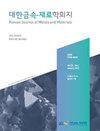High Temperature Deformation and Microstructural Evolution of Homogenized AA 2026 Alloy
IF 1.4
4区 材料科学
Q4 MATERIALS SCIENCE, MULTIDISCIPLINARY
引用次数: 0
Abstract
AA 2026 is an improved version of AA 2024, an alloy with added Zr to reduce Fe and Si content and inhibit recrystallization during hot working. Al 2026 alloy has high strength and high damage resistance, so it is widely used in aircraft parts. In this study, in order to investigate the hot workability of AA 2026 and to optimize the hot forming parameters, hot compression tests were conducted in the temperature range of 300 to 450 o C, at a strain rate of 0.01 to 10 and in the 50% strain section. The true stress–true strain curve showed a dynamic softening phenomenon while the stress increased rapidly at a small strain and then remained steady. In order to evaluate its high temperature processability, the constitutive equations for flow stress, temperature, and strain were quantified based on the Arrhenius equation, and a process strain map was prepared. The peak stress accuracy of the constitutive equation was about 98.2%, which was consistent with the experimental data of AA 2026 under strain rate and temperature conditions. In addition, scanning electron microscopy (SEM) and backscattered electron diffraction pattern analyzer (EBSD) analyses were conducted to confirm the mechanism of the dynamic softening phenomenon. The CDRX phenomenon was confirmed under the high strain condition in the low temperature region and the DDRX phenomenon in the low strain condition in the high temperature region.均匀化AA2026合金的高温变形及组织演变
AA 2026是AA 2024的改进版本,加入Zr可以降低铁和硅含量,抑制热加工过程中的再结晶。al2026合金具有高强度和高抗损伤性,因此广泛应用于飞机零部件。为了研究AA 2026的热加工性,优化热成形参数,在300 ~ 450℃的温度范围内,在0.01 ~ 10的应变速率下,在50%应变截面进行了热压缩试验。真应力-真应变曲线表现为动态软化现象,应力在小应变下迅速增大后趋于稳定。为了评价其高温加工性能,基于Arrhenius方程,量化了流动应力、温度和应变的本构方程,并绘制了工艺应变图。在应变速率和温度条件下,本构方程的峰值应力精度约为98.2%,与AA 2026的实验数据一致。此外,通过扫描电镜(SEM)和背散射电子衍射分析仪(EBSD)分析证实了动态软化现象的机理。在低温区高应变条件下证实了CDRX现象,在高温区低应变条件下证实了DDRX现象。
本文章由计算机程序翻译,如有差异,请以英文原文为准。
求助全文
约1分钟内获得全文
求助全文
来源期刊

Korean Journal of Metals and Materials
MATERIALS SCIENCE, MULTIDISCIPLINARY-METALLURGY & METALLURGICAL ENGINEERING
CiteScore
1.80
自引率
58.30%
发文量
100
审稿时长
4-8 weeks
期刊介绍:
The Korean Journal of Metals and Materials is a representative Korean-language journal of the Korean Institute of Metals and Materials (KIM); it publishes domestic and foreign academic papers related to metals and materials, in abroad range of fields from metals and materials to nano-materials, biomaterials, functional materials, energy materials, and new materials, and its official ISO designation is Korean J. Met. Mater.
 求助内容:
求助内容: 应助结果提醒方式:
应助结果提醒方式:


